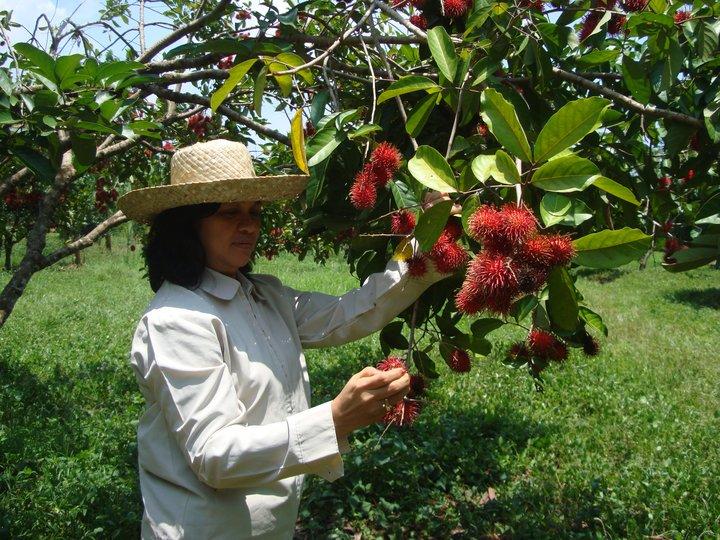New publication reveals that farmers are the best source for conservation practices

How do we conserve the amazing diversity of tropical fruit trees in a way that brings benefits to the people who look after them? Why don’t we ask the farmers? That’s exactly what the researchers and editors of Tropical Fruit Tree Diversity: Good practices for in situ and on-farm conservation decided to do.
How do we conserve the amazing diversity of tropical fruit trees in a way that brings benefits to the people who look after them? Why don’t we ask the farmers?
That’s exactly what the researchers and editors of the latest Issues in Agricultural Biodiversity book decided to do. They traveled across four Asian countries and extensively documented farmer-developed good practices for maintaining, marketing and safeguarding fruit tree species in the hopes of one day putting it all in writing for everyone to share.
The rather monumental cherry on top of their research*, Earthscan-published Tropical Fruit Tree Diversity: Good practices for in situ and on-farm conservation is now out. It outlines a framework for on-farm conservation, drawn from the real ways that communities and farmers implement conservation strategies through their everyday practices.
“When we started our research, in the four countries of interest – India, Indonesia, Malaysia and Thailand – there were no easy-to-use guidebooks about the use and management of tropical fruit tree varieties. But somehow, even without such materials, farmers still managed to cultivate a vast array of tropical fruit tree diversity through techniques they had innovated by themselves,” said Bioversity International scientist and principal editor Dr Bhuwon Sthapit.
“When we eat fruit such as vitamin C-rich citrus or antioxidant-packed mangosteen, most of the beneficial traits of these fruits are there because of farmer innovation. Consumers believe that tropical fruits are tasty, nutrient-dense, colourful and special, yet, the breeding and conservation of these fruits’ unique characteristics is not researched enough. Throughout our research project, we asked questions such as: what are the best tree conservation practices farmers have used and is such locally-available innovation widely available?” continued Dr Sthapit.
Custodian farmers – the go-to people for agricultural and tree biodiversity
Across the globe, not just in Southeast Asia, there are ‘custodian farmers’: people who maintain, adapt and disseminate agricultural and tree biodiversity and the traditional knowledge related to it.
In 2009, when the research project* started, Bioversity International and partners went to the field and studied the success of Indian, Indonesian, Malaysian and Thai custodians. Learning from the farmers, identifying the gaps and bringing in scientific knowledge, the organizations (more detail about partners can be found below) worked on strengthening their capacity in the country and scaling it up to the whole region.
“We met custodian farmers who were doing an incredible job conserving different species and varieties by uniting their traditional knowledge with tips they had learned from researchers at extension training sessions. We aimed to understand these innovators’ motivations and how their passion for conservation can be passed on to the next generation,” explained Hugo Lamers, Bioversity International scientist and co-editor of Tropical Fruit Tree Diversity.
“We couldn’t have pinpointed the good practices we did without first identifying the 83 custodian farmers who helped us. Their insight and knowledge allowed for us to discover ways in which good practices and best trees can be scaled up and mainstreamed,” added Dr Sthapit.
For example in the Ban Mae-O-Nai village of Chiang Mai, Thailand, farmer Suradech Tapuan maintains 24 mango varieties in addition to four mango wild relatives. He has developed a special side grafting technique of diverse mango scions that increases the survival rate of saplings in his dryland hillside.
“The most gratifying thing for me was the researchers’ openness to learning from farmers and the selflessness with which the farmers shared their ideas, experiences and innovations, including genetic material, when there was little or no personal gain for them,” shared Dr Ramanatha Rao, co-editor and Honorary Research Fellow at Bioversity International.
The latest addition to the Issues in Agricultural Biodiversity series, Tropical Fruit Tree Diversity: Good practices for in situ and on-farm conservation, is available for free on the Bioversity International website. Five hundred copies will be sent to libraries, universities, researchers and policymakers in developing countries.
*The Tropical Fruit Tree project ‘Conservation and Sustainable Use of Cultivated and Wild Tropical Fruit Tree Diversity: Promoting Sustainable Livelihoods, Food Security and Ecosystem Services’ was launched in 2009 with the funding of the Global Environment Facility (GEF). Implemented through the United National Environment Programme (UNEP) and lead by Bioversity International, the project’s actors focused on improving the livelihoods and food security of target communities in India, Indonesia, Malaysia and Thailand through the conservation and use of tropical fruit tree genetic resources. The national research partners of the project are the Indian Council of Agricultural Research (ICAR) in India, Indonesian Centre for Horticulture Research and Development (ICHORD) in Indonesia, Malaysian Agricultural Research and Development Institute (MARDI) in Malaysia and Department of Agriculture (DoA) in Thailand.
Photo: Rambutan (nephelium) fruit tree in the Philippines, one of the species of the 'Tropical Fruit Tree' project in Asia. Credit: Bioversity International/E. Dulloo
